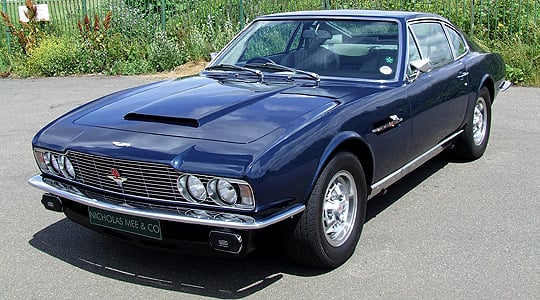
It may come as news to you that the DBS was made over a period of nearly five years. That’s surprising, as most people consider it an interim model between iconic ‘DBs’ and the ever-popular V8 Saloon.
William Towns had designed the bodywork, although the name was partly derived from the two Touring-styled experimental cars from 1966 that carried the title ‘DBSC’. The new car was, in effect, a widened (by 4.5in) and lengthened (the wheelbase by 1in) DB6 chassis with a De Dion rear axle. It was in production from October 1967 to May 1972 as a roomier alternative to the DB6 Mk I and Mk II.
The new DBS was clearly intended to carry the company’s all-new V8. However, ongoing development problems with that and, let’s be fair, a now well-sorted engine in the company’s catalogue, meant it was inevitable that the classic Aston straight-six would be offered in the DBS at launch.
The latest Aston Martin weighed just 88kg more than the DB6 and was still a very fast car. Autocar recorded a 0-60mph time of 8.6 seconds and a top speed of 140mph during its October 1967 test. The no-cost-option Borg Warner automatic transmission may blunt the car’s progress somewhat, but a high percentage of cars were fitted with Webers and Vantage cams. The ‘325bhp’ quoted by the factory for such a set-up may have been optimistic and yet a 4.2-litre engine prepared nowadays would give a very solid 300bhp, run on unleaded fuel and pull the car along with relish.
When the V8 version finally saw the light of day in spring 1970 it was impressively quick: 0-60mph in 6.0 seconds, and 162mph. The fuel-injection fitted as standard was, though, the cause of a lot of grief at the time. Today, with the aid of modern technology, a well-prepared DBSV8 on fuel injection can give a later-model Vantage a run for its money.
As with all Astons of the era, rust and electrolytic corrosion are problems, as is getting the engine in fine order. But you only really have to do the latter once. Many cars will have either been scrapped or used for parts and Zagato clones, or are now well looked after by discerning collectors. So there aren't so many to choose from, and those that are will be of a much better standard than in previous years.
The DBSV8 has the distinction of being the last model made carrying the ‘DB’ signature of Sir David Brown. The DBS six-cylinder wasn’t quite the final six-cylinder Newport Pagnell car (the ‘AM Vantage’ had that honour) but it was the last in the line of superb gentlemen’s carriages that started with the DB4. Is there a better reason to buy one than that?
You are 'Brett Sinclair' rather than 'Danny Wilde', aren't you? Have a look in the Classic Driver car database to see what's available.
Text: Classic Driver
Photo: Nicholas Mee

ClassicInside - The Classic Driver Newsletter
Free Subscription!

